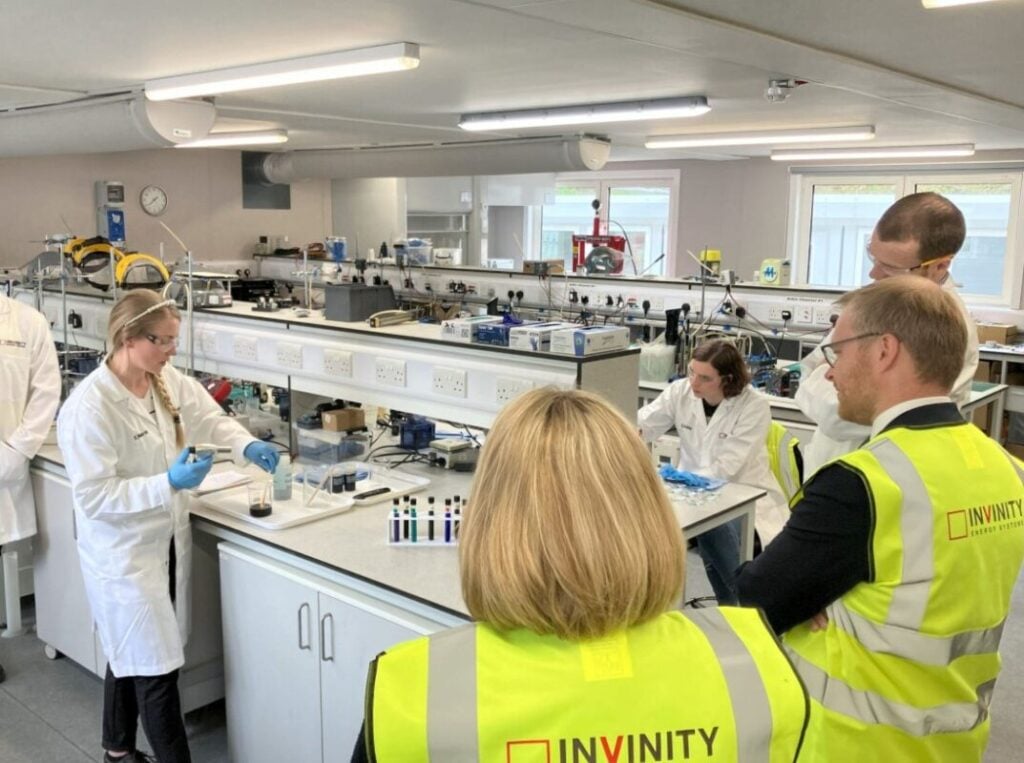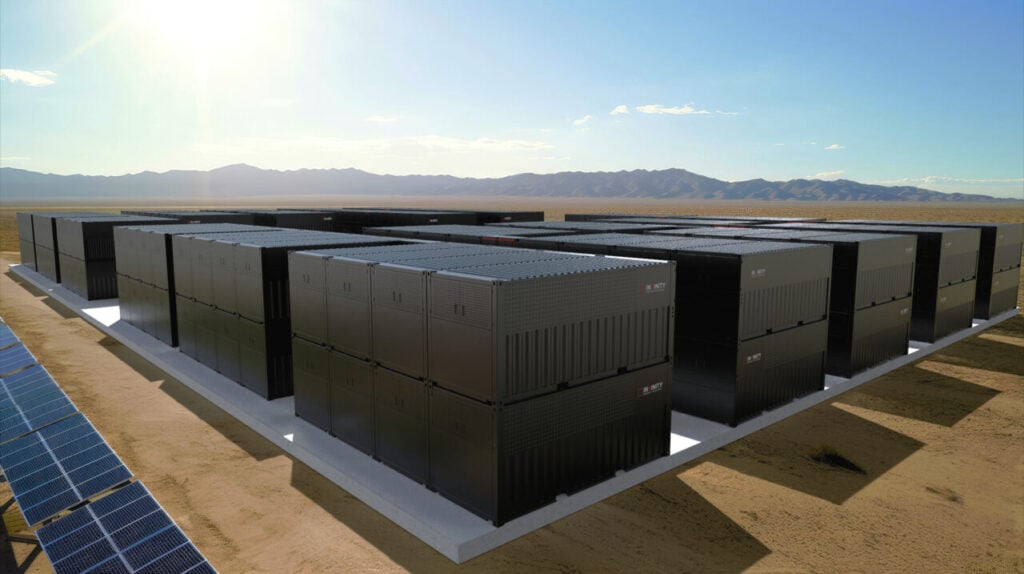
ESN Premium grills Matt Harper, president of Invinity Energy Systems, on the flow battery company’s new partnership with China’s UESNT.
Invinity president Matt Harper is speaking to ESN Premium from the back of a car, finding a few minutes while en route to visit one of the company’s flow batteries, deployed through a partnership with Gamesa Electric, near Zaragoza, Spain.
Though he mentions that the system has apparently outperformed expectations since going into operation a year ago, the topic of our conversation begins far outside Europe. It focuses on Invinity’s newest partnership with Chinese battery materials and manufacturing specialist Guangxi United Energy Storage New Materials Technology Limited (UESNT).
As covered in our news story about the licensing and royalty agreement last week, the London Stock Exchange-listed vanadium redox flow battery (VRFB) provider believes it can leverage the relationship to achieve lower costs in production and supply chain.
Try Premium for just $1
- Full premium access for the first month at only $1
- Converts to an annual rate after 30 days unless cancelled
- Cancel anytime during the trial period
Premium Benefits
- Expert industry analysis and interviews
- Digital access to PV Tech Power journal
- Exclusive event discounts
Or get the full Premium subscription right away
Or continue reading this article for free
That means licensing UESNT to manufacture Invinity’s latest generation flow battery product, Endurium, for the Chinese market.
When ESN Premium last heard from Matt Harper, as the Anglo-American VRFB company launched Endurium, in December 2024, the company president said Invinity saw China’s dominance in the flow battery space as an opportunity, rather than a threat.
As Harper explained then, the Chinese flow battery industry is not based around modular, productised VRFB solutions like Invinity’s Endurium, meaning there could be an addressable market gap the company could play into.
Furthermore, Chinese vanadium electrolyte producers Invinity was speaking with could potentially offer “phenomenal pricing” on the batteries’ key ingredient, the Invinity president said at the time.
“When we looked at the Chinese market a year ago, we saw the price point at which these flow battery projects were being built in place. That’s not going to be directly within reach with Endurium yet, but with the UESNT partnership, we think we can get the cost of the modular products down to a point where it does directly compete.”
On the flip side, and arguably even more importantly, Invinity sees UESNT as a partner that can lower the costs of its product for the global market. BloombergNEF figures from a few months ago cited the cost of flow batteries in China as being lower than half the global average.
“China is like the ‘New York’ of the flow battery industry. If you can make it there, you can make it anywhere!” Harper says.
This matters because, although Invinity has made enough progress in commercialisation that it is the only non-lithium player so far to make it onto both Bloomberg’s Tier-1 energy storage providers’ list and Solar Media Market Research’s BatteryTech Bankability ratings report, as a technology class flow batteries—and indeed non-lithium electrochemical technologies in general—still lag far behind lithium-ion in adoption across the stationary storage space.
Will China be the driver of the global ‘VRFB story’?
Regular and perhaps exceptionally devoted readers of our quarterly journal, PV Tech Power, might recall that in the Q3 2021 edition (Vol . 28), we examined the energy storage market strategies of two primary vanadium producers, Bushveld Minerals and Largo Resources.
As part of that deep dive, we heard from Erik Sardain, a principal consultant with the natural resources market analysis firm Roskill at the time, that the future success of vanadium redox flow batteries (VRFBs) would likely depend on China’s attitude toward the technology.
“I believe that the VRFB story is going to be driven by China, because it’s not only based on economics, it’s also based on politics. Because if the Chinese government says, ‘Let’s go for it,’ then they will go for it,” Sardain said.
Indeed, the Chinese government did go for it. In addition to existing in its natural form in the ground, the metal is a by-product of steelmaking. Through this, the country is already the biggest source of vanadium in the world, and the government has also turned its hand to supporting the deployment of large-scale flow batteries.
While that programme saw some stops and starts, the first long-duration projects at a scale of hundreds of megawatts and many more megawatt-hours have since come online.
For Invinity, UESNT symbolised the progress China has made in technology and materials since its energy storage policy focus diversified to include flow batteries, as well as lithium-ion (Li-ion) and other tech.
“Electrolyte, or the vanadium that stands behind it, is really what got the UESNT team excited about this deal in the first place. Their pedigree is in minerals processing [in the BESS space],” Harper says as he makes his way over to the Gamesa Electric project site.
“Without getting into too sensitive detail, UESNT are implementing some processing techniques and supply chain optimisations that, in our view, really change the game in terms of how the medium can be converted from materials in the ground, or recycled materials, to the electrolyte that we need.”
Invinity perceived UESNT to be the best-in-class in the world at doing this, although Harper says that he expects others to follow its lead. This would be a long-term win-win, creating “a fundamentally downward pressure on the prices of the materials and the systems” across the industry.
From upstream cost reduction to downstream demand growth
However, he says, anyone concerned that Invinity’s partnership with a low-cost Chinese manufacturer could spell the end of production from its existing assembly plants in Canada and Scotland, UK, need not worry.
“We still intend to manufacture our core technology ourselves. That’s a critical piece of what we do. Not only from an IP management perspective, but really, the manufacturing of our stacks and the optimisation of how the system works at a controls and electronics level, we know how to do that better than anyone else,” he says.
“When it comes to manufacturing our stacks, it’s not about stack design. It’s about the processes, the quality control. It’s about the techniques in the manufacturing process that get us to the kind of performance and costs that our products need.”
Invinity will utilise the UESNT team, its manufacturing relationships and source of supply, but intends for those to feed the factories that the company already has in operation.

For flow batteries to proliferate as a commercial prospect, it isn’t just supply-side progress that needs to be made. Downstream demand also needs to be there.
With liquid electrolyte tanks that can be scaled up to provide higher storage capacities without the need for additional battery stacks, power electronics, and thermal management systems, Invinity and its fellow providers have long advocated that flow batteries could be the solution for long-duration energy storage (LDES) applications.
Although power and energy market structures typically do not reward this characteristic, a growing number of governments have noted that market redesign or direct support will be needed in high renewable energy penetration electric grids when the sun doesn’t shine and the wind doesn’t blow.
One prominent example is the UK’s forthcoming cap-and-floor revenue underwriting scheme for LDES of 8-hour duration or more.
In February, Invinity announced that developer Frontier Power was targeting multiple bids in the cap-and-floor competitive solicitations using up to 2GWh of Invinity flow batteries.
According to announcements made since then, around nine developers are thought to be preparing bids using the company’s tech, with each project proposal of 400MWh or above.
Harper says Invinity hasn’t publicly disclosed how many projects in total it is looking at with developers for the UK scheme. He emphasises, however, that with the minimum project sizes discussed, even a small number of projects would represent “the gigawatt-hours’ worth of capacity that would be needed for the programme.”
“We know that we are not going to win 100% of what has been submitted. In fact, the entire programme looks like it’s pretty significantly over capacity, which is great. We’ll use that competitive process to make sure that only the projects that are going to be delivered at the right place for the right purpose and have the right benefit for the UK grid are the ones that go forward,” Harper says.
Invinity sees that optimisation, by the hand of the UK’s regulator, Ofgem, as it picks out the winning bids, soaking up some of the 6GWh VRFB supply that the UESNT agreement provides a framework for.
Elsewhere in the world, Invinity is excited by LDES solicitations in the US, particularly New York and California as well as in the Canadian provinces of British Columbia and Ontario. The latter will encourage non-lithium projects with “something of a local flavour,” which could apply to Invinity with its production site in Vancouver, Harper says.
“Given how successful we were with engaging developers for cap-and-floor, we think we’ve got a pretty good chance of getting the same kind of traction for some of those programmes in North America.”
‘Intersection of two forces’
Harper claims Invinity is enthused by interest from developers globally, who he says “are seeing the intersection of two forces.”
“One is the limitations that people are starting to perceive on what lithium batteries can do in the energy-intensive applications that we’re targeting.”
This is combining with the second force, or driver, which is where Invinity claims costs on Endurium are trending even since the product launched six months ago.
“Especially as we start manufacturing larger volumes of the product, we’re able to quote a lot more aggressive price points. The intersection of those two things is opening the door to a lot more business for us,” Harper says.
This article has been amended to reflect that Matt Harper is president of Invinity Energy Systems, not CCO as previously published.
